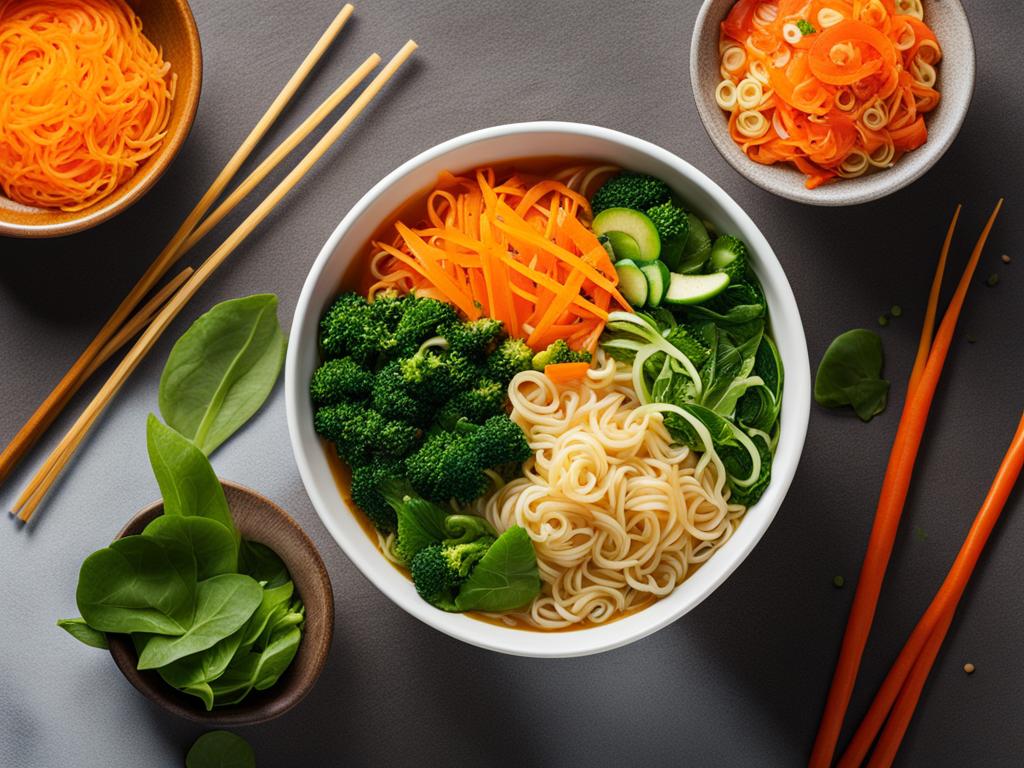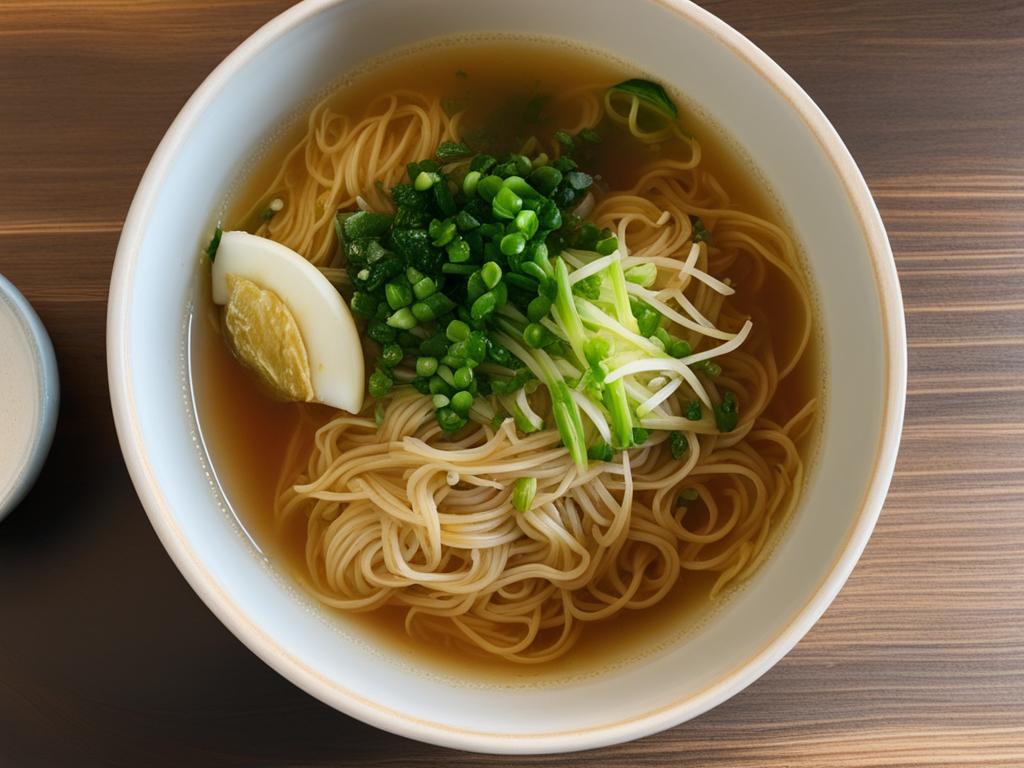Ramen noodles have become a popular staple in many households due to their affordability and convenience. However, it’s essential to understand the nutritional value of these instant noodles to make informed choices about their consumption.
Instant ramen noodles are typically made from wheat flour, vegetable oils, and flavorings. They are low in calories but lack important nutrients such as protein, fiber, vitamins, and minerals. Moreover, they contain additives like monosodium glutamate (MSG) and preservatives like tertiary butylhydroquinone (TBHQ) that may have potential health effects.
While ramen noodles can provide a quick and easy meal option, they should not be relied upon as a nutritional substitute. Understanding the facts about ramen noodles nutrition can help individuals make healthier choices and incorporate them into a balanced diet.
Key Takeaways:
- Ramen noodles are low in calories but lack essential nutrients like protein, fiber, vitamins, and minerals.
- They often contain high amounts of sodium, which can have negative health effects.
- Instant ramen noodles may contain additives such as MSG and preservatives like TBHQ.
- Ramen noodles should not be a staple food and should be consumed in moderation.
- It’s important to prioritize a diet rich in whole, unprocessed foods for optimal nutrition.
Nutritional Value of Ramen Noodles
When it comes to the nutritional value of ramen noodles, it’s important to understand what you’re really getting in each serving. While instant ramen noodles might be low in calories, they lack many essential nutrients that your body needs to thrive. Let’s take a closer look at the nutritional profile of these popular noodles.
Calories and Macronutrients
A typical serving of chicken-flavored instant ramen noodles contains approximately 188 calories. However, it’s worth noting that this calorie count can vary depending on the brand and flavor. In terms of macronutrients, a serving typically contains 27 grams of carbohydrates, 7 grams of total fat, 5 grams of protein, and 1 gram of fiber. While the calorie content may seem low, it’s important to remember that the nutritional value is limited.
Sodium Content
One of the main concerns with ramen noodles is their high sodium content. A single serving of chicken-flavored ramen noodles contains about 891 mg of sodium. This high sodium content can be attributed to the flavor packet included in the package. Consuming excessive amounts of sodium can have negative effects on your health, such as increased blood pressure and an increased risk of heart disease. It’s important to be mindful of your sodium intake, especially if you have high blood pressure or other underlying health conditions.
Cooking Instructions
Preparing ramen noodles is quick and easy. Simply add the noodles to a pot of boiling water and cook them for a few minutes until they are tender. Drain the water and add the flavor packet to enhance the taste. Feel free to get creative and add your own ingredients, such as vegetables or protein, to make the dish more nutritious and flavorful.
| Nutrient | Amount per Serving |
|---|---|
| Calories | 188 |
| Carbohydrates | 27g |
| Total Fat | 7g |
| Protein | 5g |
| Fiber | 1g |
| Sodium | 891mg |
Keep in mind that the nutritional content may vary depending on the specific brand and flavor of ramen noodles you choose. It’s always a good idea to read the packaging and check the nutrition facts to get a more accurate understanding of what you’re consuming.
“While instant ramen noodles might be low in calories, they lack many essential nutrients that your body needs to thrive.”
While ramen noodles may be a convenient and tasty option, they shouldn’t be relied upon as a primary source of nutrition. It’s important to incorporate a variety of nutrient-dense foods into your diet to ensure you’re getting all the vitamins, minerals, and other essential nutrients your body needs to function optimally. With a balanced approach to nutrition, you can enjoy ramen noodles in moderation as part of a well-rounded diet.
Health Impact of Ramen Noodles
While ramen noodles may be convenient and tasty, they do not offer significant health benefits. They lack important nutrients such as protein, fiber, vitamins, and minerals. Regular consumption of instant ramen noodles has been linked to poor overall diet quality and an increased risk of metabolic syndrome, which is a group of symptoms including excess abdominal fat, high blood pressure, high blood sugar, and abnormal blood lipid levels. It is recommended to limit the intake of ramen noodles and to not rely on them as a meal substitute. Instead, it is advised to prioritize a diet consisting of whole, unprocessed foods that provide a wide range of nutrients.
| Nutrients | Amount per Serving |
|---|---|
| Protein | Low |
| Fiber | Low |
| Vitamins | Low |
| Minerals | Low |
“Regular consumption of instant ramen noodles has been linked to poor overall diet quality and an increased risk of metabolic syndrome.”
While ramen noodles may be a convenient and affordable option, they should not be relied upon as a dietary staple. The lack of essential nutrients and high sodium content in ramen noodles may contribute to health issues over time. It is essential to prioritize a balanced diet that includes a variety of whole, unprocessed foods to support overall health and well-being.
Sodium Content in Ramen Noodles
One of the main concerns with instant ramen noodles is their high sodium content. Consuming excessive amounts of sodium can negatively impact health and has been linked to an increased risk of heart disease, stroke, and stomach cancer. A single package of ramen noodles contains approximately 1,760 mg of sodium, which is significantly higher than the recommended daily intake of 2 grams set forth by the World Health Organization. It’s important to limit the consumption of ramen noodles, especially for individuals who are sensitive to salt or at risk for high blood pressure.
Excessive sodium consumption is associated with various health risks, including:
- Increased blood pressure: High sodium intake can raise blood pressure levels, increasing the risk of heart disease and stroke.
- Fluid retention: Consuming too much sodium can lead to fluid retention, causing bloating and swelling.
- Impaired kidney function: Excess sodium can strain the kidneys, potentially leading to reduced kidney function over time.
- Stomach cancer: Studies have suggested a link between high sodium intake and an increased risk of stomach cancer.
To put the sodium content of ramen noodles into perspective, consider the following comparison:
One package of ramen noodles contains approximately 88% of the recommended daily sodium intake according to the World Health Organization.
Reducing sodium intake is crucial for maintaining overall health. Limiting the consumption of ramen noodles and opting for lower-sodium alternatives can help mitigate the negative health effects associated with high sodium intake. It’s also important to read nutrition labels and be mindful of sodium content in other processed foods.

By being aware of the sodium content in ramen noodles and making informed decisions about their consumption, individuals can take steps to prioritize their health and reduce the risk of associated health problems.
Additional Ingredients in Ramen Noodles
When it comes to instant ramen noodles, the flavor packet is key to creating that tasty broth. However, it’s important to understand that these noodles often contain additional ingredients that may impact your health.
One common ingredient found in ramen noodles is tertiary butylhydroquinone (TBHQ). TBHQ is a preservative that extends the shelf life of the noodles but may have adverse health effects in large doses. While the amounts found in ramen noodles are generally considered safe, it is important to be mindful of the potential risks associated with chronic exposure to this preservative.
Another controversial ingredient found in many brands of ramen noodles is monosodium glutamate (MSG). MSG is a flavor enhancer that can cause adverse reactions in certain individuals, such as headaches and high blood pressure. While MSG is generally recognized as safe by regulatory authorities, some people may be sensitive to it and experience these symptoms.
It’s crucial to be aware of these additives and their potential effects on your health when consuming ramen noodles. Reading the ingredient labels and opting for brands with minimal additives can help make a more informed choice.
The Role of TBHQ in Ramen Noodles
Tertiary butylhydroquinone (TBHQ) is a common preservative used in ramen noodles to prolong their shelf life. However, there have been concerns raised about its potential health effects.
Some studies have suggested that high doses of TBHQ may have adverse effects on health, including potential damage to DNA and an increased risk of cancer. However, it’s important to note that the amounts found in food are generally considered safe for consumption.
Understanding MSG in Ramen Noodles
Monosodium glutamate (MSG) is another ingredient frequently found in ramen noodles. It is a flavor enhancer that gives the noodles a savory taste. However, MSG has been a topic of controversy due to its potential health effects.
Some individuals may be particularly sensitive to MSG and experience symptoms such as headaches, flushing, and sweating. Studies have also linked MSG consumption to high blood pressure in individuals who are already at risk. It’s important to note that the FDA considers MSG safe for consumption when consumed in normal amounts.
Table: Additives Found in Ramen Noodles
| Additive | Purpose | Potential Health Effects |
|---|---|---|
| TBHQ | Preservative to extend shelf life | Potential adverse effects in high doses |
| MSG | Flavor enhancer | Possible adverse reactions in sensitive individuals |
While the use of these additives in ramen noodles is generally considered safe, it’s important to consume them in moderation and be aware of any personal sensitivities or health concerns.

Limitations of Ramen Noodles as a Staple Food
While ramen noodles may be a convenient and affordable option, they are not recommended as a staple food. Regular consumption of ramen noodles has been associated with poor diet quality and an increased risk of metabolic syndrome.
Ramen noodles are low in fiber and protein, which are important factors in weight loss and overall nutrition. Additionally, they do not provide a wide range of essential vitamins and minerals. Incorporating a variety of whole, nutrient-dense foods into the diet is crucial for optimal health.
“The regular consumption of instant noodles is associated with unfavorable dietary patterns and an increased risk of metabolic syndrome.” – Journal of Nutrition and Metabolism
When it comes to weight loss, ramen noodles may not be the best choice. Although they are low in calories, they lack the satiating effects of fiber and protein, leading to potential hunger shortly after consumption.
It’s important to prioritize a balanced diet that includes a variety of nutrient-dense foods for weight management and overall well-being.
The Impact of Nutritional Deficiencies
Regularly relying on ramen noodles as a primary food source can result in nutritional deficiencies. These instant noodles lack essential vitamins and minerals that are vital for overall health. Some of the key nutrients that may be lacking in the ramen noodles diet include:
- Protein: Ramen noodles are very low in protein content, which is crucial for muscle repair, growth, and overall body function.
- Fiber: Fiber is essential for maintaining healthy digestion, regulating blood sugar levels, and promoting satiety.
- Vitamins and minerals: Ramen noodles lack a wide range of essential vitamins and minerals, including vitamin C, vitamin D, calcium, and iron.
It’s important to diversify your diet by incorporating a variety of nutrient-rich foods to avoid these deficiencies.
To illustrate the limitations of ramen noodles as a staple food, let’s take a look at a comparison between a typical ramen noodles meal and a balanced, nutrient-dense meal:
| Ramen Noodles Meal | Balanced, Nutrient-Dense Meal |
|---|---|
| Instant ramen noodles with flavor packet | Grilled chicken breast with mixed vegetables |
| Low in protein, fiber, vitamins, and minerals | Provides essential protein, fiber, and a variety of vitamins and minerals |
| High in sodium | Low in sodium |
As you can see, the balanced, nutrient-dense meal provides a wider range of nutrients compared to a typical ramen noodles meal.
While ramen noodles can be enjoyed occasionally as a quick and easy meal, they should not be relied upon as a staple food. Prioritizing a diet that includes a variety of whole, unprocessed foods will ensure adequate nutrition and support overall well-being.
Making Ramen Noodles Healthier
If you enjoy eating ramen noodles, there are several ways to make them healthier by incorporating nutritious additions and making mindful choices. By doing so, you can enhance the overall nutrient content and reduce certain undesirable aspects of these popular instant noodles.
Adding Fresh or Cooked Vegetables
One of the easiest ways to make ramen noodles healthier is to add fresh or cooked vegetables to your dish. Include options like carrots, broccoli, onions, or mushrooms to increase the nutritional value. These vegetables provide essential vitamins, minerals, and dietary fiber, making your meal more balanced and satisfying.
Topping with Lean Protein Sources
To boost the protein content of your ramen noodles, consider adding lean protein sources as toppings. Opt for options such as grilled chicken, fish, or tofu to provide a nutritional punch. Protein helps to promote satiety and supports muscle health, making your meal more satisfying and nourishing.
Opting for Low-Sodium Versions
Ramen noodles are typically high in sodium, which can be detrimental to health if consumed in excess. To reduce the overall sodium content of your meal, look for low-sodium versions of ramen noodles or consider using less of the included seasoning packet. By doing so, you can lower your sodium intake and mitigate potential health risks associated with excessive sodium consumption.
Creating a Homemade Broth
Another way to make ramen noodles healthier is by creating a homemade broth using low-sodium chicken stock and adding herbs and spices. This allows you to control the sodium content and add flavor without relying on the high-sodium flavor packets that come with instant ramen noodles. Homemade broths can enhance the taste and nutritional profile of your meal while reducing the reliance on processed ingredients.
By implementing these strategies, you can transform a simple bowl of ramen noodles into a more nutritious and satisfying meal. The table below summarizes these healthier alternatives:
| Healthy Additions to Ramen Noodles | Benefits |
|---|---|
| Adding fresh or cooked vegetables (carrots, broccoli, onions, mushrooms) | Increases nutrient content and dietary fiber |
| Topping with lean protein sources (chicken, fish, tofu) | Boosts protein intake and promotes satiety |
| Opting for low-sodium versions of ramen noodles | Reduces overall sodium intake and associated health risks |
| Creating a homemade broth with low-sodium chicken stock and herbs/spices | Allows for customization and lowers reliance on high-sodium flavor packets |

By making these simple adjustments, you can transform your ramen noodles into a healthier and more nourishing meal. However, it’s important to remember that ramen noodles should still be consumed in moderation as part of a balanced diet that includes a variety of nutrient-dense foods.
Comparison to Fresh Ramen Noodles
When discussing ramen noodles, it’s important to distinguish between instant ramen noodles and fresh ramen noodles. While instant ramen noodles are widely known and easily accessible, fresh ramen noodles offer a more authentic and nutritious experience. Fresh ramen noodles are traditionally served in flavorful soups with a variety of toppings, such as eggs, duck meat, and vegetables, providing a more balanced nutritional profile.
The ingredients in fresh ramen noodles differ from those in instant ramen noodles. Fresh ramen noodles are typically made from wheat flour, water, and in some cases, kansui, a type of alkaline mineral water that gives the noodles their springy texture. They are made from scratch or sourced from reputable noodle makers, ensuring a higher quality product.
Fresh ramen noodles have a higher nutritional value compared to their instant counterparts. The use of fresh ingredients and the absence of additives give fresh ramen noodles an advantage in terms of freshness, flavor, and nutrition. They provide a wider array of nutrients, including protein, fiber, and essential vitamins and minerals like iron and B vitamins.
The freshness and quality of the ingredients used in fresh ramen noodles result in a more wholesome and satisfying meal. The combination of nourishing broth, tender noodles, and flavorful toppings makes fresh ramen noodles a popular and enjoyed dish in Chinese and Japanese cuisine. It’s no wonder that they have gained a reputation as a comfort food that offers both taste and nutrition.
Instant ramen noodles are convenient, but fresh ramen noodles boast superior flavor and nutritional value. With fresh ramen noodles, you can enjoy a delicious and well-rounded meal that nourishes the body and delights the taste buds.
To get a visual idea of the difference between instant ramen noodles and fresh ramen noodles, take a look at the following table:
| Comparison of Instant Ramen Noodles and Fresh Ramen Noodles | |
|---|---|
|
|
Instant ramen noodles are easily prepared, but fresh ramen noodles offer a more satisfying and nutrient-packed dining experience. To truly appreciate the flavors and benefits of ramen noodles, opt for fresh ramen noodles whenever possible.

Ramen Noodles and Weight Loss
While ramen noodles are often considered a quick and convenient meal, they may not be the best choice for those looking to lose weight. Although they are low in calories, it’s important to consider their overall nutritional value when it comes to weight management.
Ramen noodles have a small package size, yet they can be calorie-dense due to their high carbohydrate content. Additionally, they lack essential nutrients like fiber and protein, which play a crucial role in promoting satiety and supporting weight loss goals.
Consuming ramen noodles as a full meal may leave you feeling hungry again shortly after, which can lead to overeating or snacking on high-calorie foods throughout the day, hindering your weight loss efforts. This is why incorporating a variety of nutrient-dense foods into your diet is essential.
To make ramen noodles a healthier option for weight loss, consider the following strategies:
- Add fresh or cooked vegetables such as spinach, carrots, or mushrooms to increase the nutritional value and fiber content of your meal.
- Include lean protein sources like grilled chicken, shrimp, or tofu to enhance the satiety and overall nutritional profile of your ramen noodles.
- Opt for low-calorie or low-sodium varieties of ramen noodles, or consider making your broth from scratch to control the ingredients and reduce the overall sodium content.
- Practice portion control by dividing the package into smaller servings and avoiding the temptation to eat the entire package in one sitting.
By making these adjustments, you can enjoy ramen noodles while still prioritizing your weight loss goals and maintaining a balanced diet.
Remember, weight loss is a journey that requires a holistic approach. While ramen noodles can be a part of a balanced diet, it’s important to prioritize the consumption of whole, nutrient-dense foods that provide a wide range of essential nutrients.
The Impact of MSG and TBHQ in Ramen Noodles
Ramen noodles often contain two controversial ingredients known as monosodium glutamate (MSG) and tertiary butylhydroquinone (TBHQ). These additives can have various effects on health and have been a subject of concern in the food industry. Let’s take a closer look at each of these ingredients and their potential impact on ramen noodles.
Monosodium Glutamate (MSG)
MSG is a flavor enhancer commonly used in processed foods, including ramen noodles. While MSG is recognized as safe by major regulatory bodies, it has faced criticism due to reported adverse reactions in certain individuals. Some individuals may experience symptoms such as headaches, flushing, sweating, and high blood pressure after consuming MSG-containing foods. However, extensive scientific research has not consistently supported these claims, and many people consume MSG without experiencing any negative effects.
Tertiary Butylhydroquinone (TBHQ)
TBHQ is a synthetic preservative that is added to ramen noodles to extend their shelf life. Like other preservatives, it helps prevent spoilage and maintain product quality. However, concerns have been raised about the potential health effects of chronic exposure to TBHQ. Animal studies have shown that high doses of TBHQ may have toxic effects on the liver, reproductive system, and immune system. However, the amounts of TBHQ found in food products are generally considered safe for human consumption.
While MSG and TBHQ are both present in ramen noodles, it’s important to note that the quantities used are regulated and generally regarded as safe for consumption. However, individuals who are sensitive to food additives may want to exercise caution and avoid consuming ramen noodles and other highly processed foods that contain MSG or TBHQ.
To make an informed choice, it’s always a good idea to read product labels and choose ramen noodle brands that prioritize natural ingredients and minimize the use of additives. Additionally, incorporating a variety of fresh, whole foods into your diet can help balance any potential negative impact of consuming ramen noodles.
Remember to consult with a healthcare professional if you have specific concerns or dietary restrictions.
Considering Alternative Carbohydrate Sources
While ramen noodles are a cheap and convenient source of carbohydrates, there are other healthy and affordable options available. Brown rice, oats, and potatoes are examples of versatile and nutrient-dense carbohydrate sources that can be included in a balanced diet. These alternatives provide more fiber, vitamins, and minerals compared to ramen noodles and can contribute to overall better health. It’s important to prioritize the consumption of whole, unprocessed carbohydrate sources for optimal nutrition.
Comparing Carbohydrate Sources:
| Carbohydrate Source | Benefits |
|---|---|
| Brown Rice | High in fiber, vitamins, and minerals Supports digestion and heart health Provides sustained energy |
| Oats | Rich in fiber, antioxidants, and important nutrients Helps lower cholesterol levels Supports weight management |
| Potatoes | Good source of vitamins and minerals High in potassium and vitamin C Provides energy and aids in muscle function |
By choosing these alternative carbohydrate sources, you can enjoy a variety of flavors and textures while providing your body with essential nutrients. Incorporate them into your meals to create a well-rounded and nutritious diet.
Also Read : Unlocking The Mystery: Coke Nutrition Facts Explained
Conclusion
In conclusion, ramen noodles may be a popular and convenient choice for many individuals due to their low cost and quick preparation time. However, when it comes to overall nutrition, they fall short. Despite being low in calories, ramen noodles lack essential nutrients like protein, fiber, and important vitamins and minerals.
Furthermore, the high sodium content in ramen noodles can have negative effects on health, including an increased risk of heart disease and other health conditions. It is important to note that regular consumption of ramen noodles has been linked to poor diet quality and an increased risk of metabolic syndrome.
While it may be tempting to rely on ramen noodles as a quick and easy meal option, it is crucial to prioritize a diet that incorporates a variety of nutrient-dense foods. Making healthier choices by adding fresh vegetables and lean protein to ramen noodles can help increase their nutritional value. Ultimately, a well-rounded diet that includes whole, unprocessed foods is essential for optimal health.
FAQ
Q: What are the nutrition facts of ramen noodles?
A: A typical serving of ramen noodles contains a high level of carbohydrates and sodium. It also provides some amount of protein and a small number of calories.
Q: Are ramen noodles bad for you?
A: Eating instant ramen noodles frequently may lead to health issues due to high sodium and saturated fat content. It is recommended to eat them in moderation.
Q: What are the health risks associated with ramen noodles and other related foods?
A: Overconsumption of instant noodle products and other related foods can lead to cardiovascular problems, metabolic syndrome in women, and increased risk of developing chronic illnesses.
Q: How many calories are there in one packet of ramen noodles?
A: One packet of ramen noodles contains approximately 380-400 calories. This can vary based on the brand and specific ingredients.
Q: What is the daily value of sodium per day?
A: The recommended daily value of sodium is 2300 milligrams. Consuming one serving of ramen noodles may contribute a significant portion towards the daily sodium intake.
Q: What do ramen noodles contain?
A: Ramen noodles often contain ingredients like wheat flour, salt, and various additives. Some may also contain dried vegetables and flavor enhancers.
Q: How much of a nutrient such as magnesium do ramen noodles provide?
A: While ramen noodles do not provide a significant amount of essential nutrients, they may contain a small amount of magnesium along with other healthy nutrients in smaller quantities.
Q: Can you microwave ramen noodles?
A: Yes, you can microwave ramen noodles by placing them in a microwave-safe bowl with water, then heating them for a few minutes. Be cautious, as the bowl and contents may become very hot.
Q: What are some alternatives to enhance the nutritional value of ramen noodles?
A: Adding ingredients such as soft-boiled eggs, soy-based products like miso paste, and lean proteins can help improve the nutritional content of ramen noodle soup.
Q: Is it safe to consume ramen noodles if they are my go-to meal as a busy college student?
A: While convenient, relying heavily on instant noodle consumption may lead to health issues due to the high sodium and carbohydrate values. It is important to balance their intake with other nutritious food options.







